Вы здесь
Architectural symbol of neutrality.
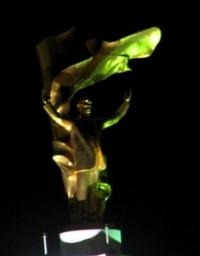
Excursion on monuments history in Ashgabad.
- December 12, 1996 – the President of Turkmenistan S. Niyazov laid the memorial stone on the site of the future monument.
- December 26, 1996 – the competition on the preliminary design of the monument was announced.
- March 12, 1997 – As the result of a competition the project of the architect Erola Tabanja was announced as the winner.
- July 1, 1997 – the Degree of the President of Turkmenistan about the construction of the Arch of Neutrality and signing of the building contract with the Turkish company “Polymex” was published.
- December 12, 1998 – the day of solemn unveiling of the Arch of Neutrality.
Excursion from Ashgabad to ancient settlement Old Nisa.
Technical Parameters of the construction achitectural symbol of neutrality inn Ashgabad.
- General height of the structure – 75 m.
- General height of the statue of President Saparmurat Turkmenbashi – 12 m.
- At a height of 21,5 m – a café for 100 persons.
- At a height of 26 m – the first viewing site for 100 persons.
- At a height of 49,5 m – the second viewing site for 60 persons.
There are cities, known at once by a unique and symbolic building or monument which is famous all over the world. Paris has Eiffel tower, London has Big Ben, Washington – the Capitol, Moscow – Spasskaya tower, St.-Petersburg – the Admiralty etc.
Continuing this list, we can now add Ashkhabad and the Arch of Neutrality. With an unprecedented construction speed of just one year, a beautiful monument ultra-modern forms, the latest technologies, and a national semantic meaning in its construction and decoration.
The monument, named the Arch of Neutrality, has become an urban symbol which serves as a powerful reference point in the city. It is a beacon, catching the eye day and night with its majestic beauty.
Yet despite its size, it successfully creates an impression of ease and light rushing up to the sun stars. The idea behind this exotic monument is closely connected with an extremely important event in the nation’s history, which took place in New York on December 12, 1995.
At the meeting on the UN General Assembly, representatives of 185 member states voted unanimously for acceptance of a special resolution entitled ”Permanent Neutrality of Turkmenistan”.
Behind this event was a widespread recognition of Saparmurat Turkmenbasi’s foreign policy course. He has also managed to appreciate immediately the great significance peace and security for the sometimes clouded region of Central Asia.
Perhaps only President Niyazov, through his deep conviction, could in such a short period convince the others of the right path planned by him, after gaining great support from both inside the country and throughout the world community.
The Arch of Neutrality is perceived as the logical link in a number of his arguments and has become the bright embodiment of Turkmenistan’s pride for their Native Land, which for the first time after centuries in the shadow of history has suddenly emerged in the larger political arena as a sovereign state with all the attributes of independence.
Alongside actively developing the economy. An important role has been played by the independent diplomacy of Turkmenbashi and his philosophy of national revival and solidarity. The need for monuments, without an apparent functional necessity, is peculiar to all developed societies.
Moreover, those constructions, which from the most ancient times were built to spiritually uplift the people, different from others by the extra care expended in their performance, forms and dimensions.
These are the sanctuaries of the first civilizations of the world, the temples of world religions, which at last became classic antique monuments and the direct predecessors of modern monumental art.
All of them reflect their epoch like a mirror, serving not just their contemporaries, but later generations. That’s why creation of major state monuments has always been entrusted to the finest masters who have proved they are worthy of the honor.
The Arch of Neutrality in Ashkhabad is no different. The final project was chosen on a competitive basis from nine works, and each author put his soul and understanding of the problem into his plans, aiming to create a majestic structure combining elements of the Turkmen people’s national culture with the achievements of XX century architecture, embodying in a symbol of white the stability of independent, neutral Turkmenistan.
A professional jury awarded first place to the 40 year old architect, Erol Tabanja, who heads the “Polymex” building company. This company has a proven track record in Turkmenistan, and coped admirably with the assigned task.
The monument was completed on schedule, and on the eve of celebration of the third anniversary of neutrality, an arch was formed in all its magnificence. Erol Tabanja revealed that this work was very important for him. It required maximum concentration and his finest creative efforts, and it soon became clear what a vital place the structure would take in the layout of the city, and what ideological importance it bore.
Following Saparmurat Turkmenbashi’s idea, the inspiration for the Arch of Neutrality was the traditional Turkmen trivet – a stable tripod, used for holding a boiler, under which a fire is kindled.
This transparent image of nationhood tells of the inextinguishability of the home and the strength of the common house, which is the state. In the project the trivet was transformed into three widely curved pylons connected by disk and rings of different diameters and thickness.
These are the viewing sites, located on different levels, where at any time of day a perfect panorama of Ashkhabad opens up. Visitors are transported to the first level by funiculars, while the third is equipped with ladders as a fire precaution measure. Here, at a height of 21.5 meters, there is a circular café-bar with a panoramic view.
The transparent lift takes visitors to 50 meters, where the upper viewing platform is situated. At 63 meters, there is a 12-meter sculpture of Saparmurat Turkmenbashi on a background of a fluttering flag.
This part of the monument rotates slowly, making one full every day. The President thus seems to survey his country, meeting and seeing off the sun the Arch of Neutrality reaches a total of 75 meters, making it the highest building in Turkmenistan, above the 600 year old Kutlug-Timur minaret.
The Arch of Neutrality is faced with white marble, with bronze relief compositions from Turkmen history on the sides of the pylons. Vertical sections of the pylons between the upper and lower survey sites are combined with five identical bronze rings, each featuring relief lattices with images of ghels - basic carpet elements from the various Turkmen tribes.
These rings symbolize the unity of the people in creating the new state under the leadership of Saparmurat Turkmenbashi. It should be mentioned that the Arch of Neutrality is an excellent example of so-called light architecture. In the twilight it is skillfully illuminated with the help of a system of floodlights, transforming its appearance.
Adjoining the Arch, a square completes the ensemble. A modification of nearby town building, and amendments to their scale has revalued the function and architectural appearance of the Square of Neutrality.
With various sites for relaxing beside artificial reservoirs it has become one of the central metropolitan squares and is linked to a general system of streams flowing downtown during holidays and public events.
At the centre of the renovated square, the cascade of fountains meets the Arch. The height of the water jet of the central fountain reaches 30 meters. Flagstaffs with banners of UN member countries form a line in front of the Karakumstroi façade…
The architectural symbol of neutrality at the centre of the Turkmen capital near the Palace of Turkmenbashi has naturally come to signify much more for Ashkhabad than is reflected in its laconic title.
It expresses goodwill and openness, and shines with a optimism and confidence in the happy future of mankind.
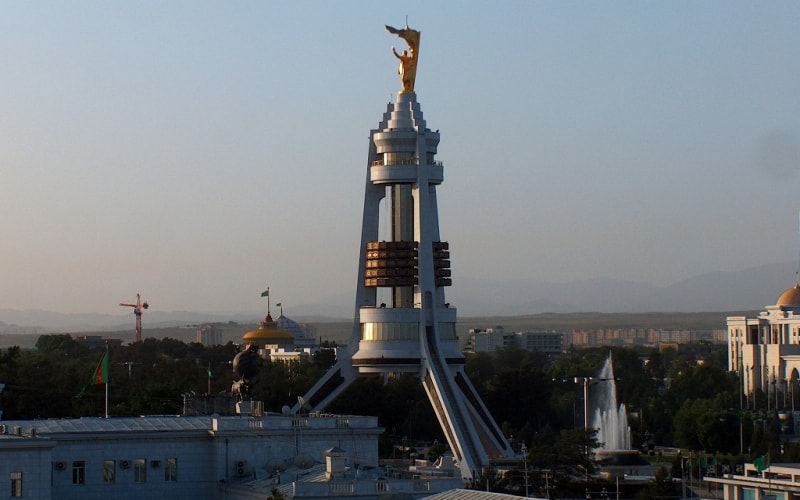

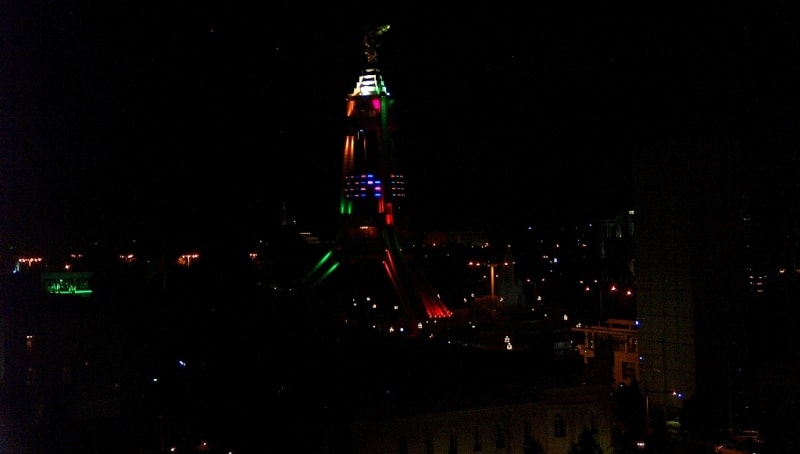
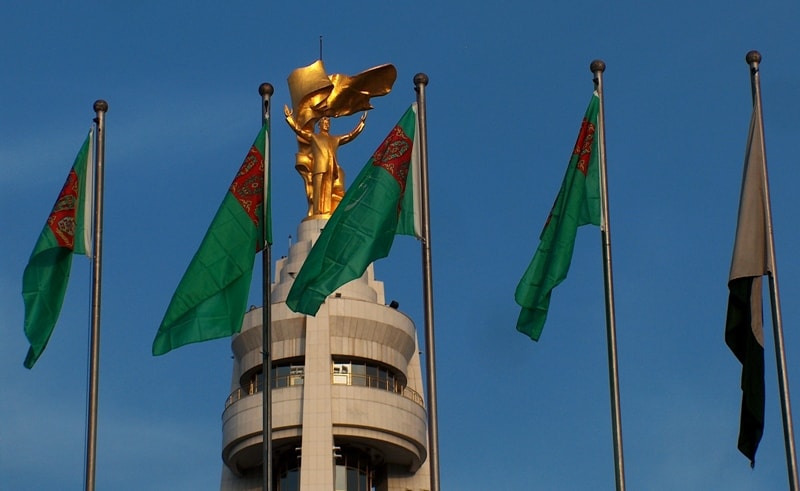
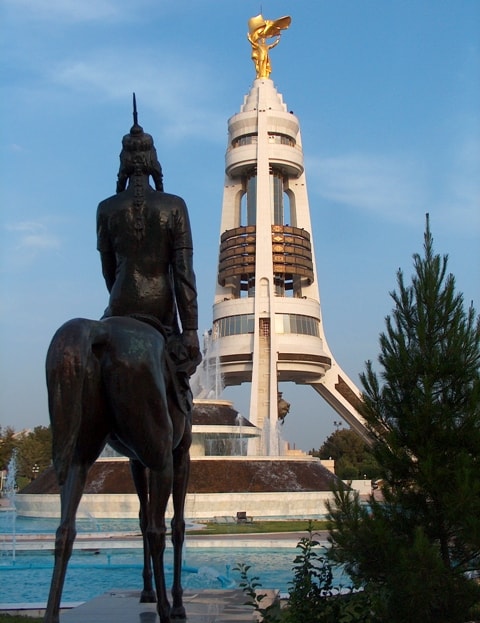
Authority:
http://www.turkmenistaninfo.ru Ruslan Muradov. “Tourism and Development” №1,1999
Alexander Petrov
photos.







